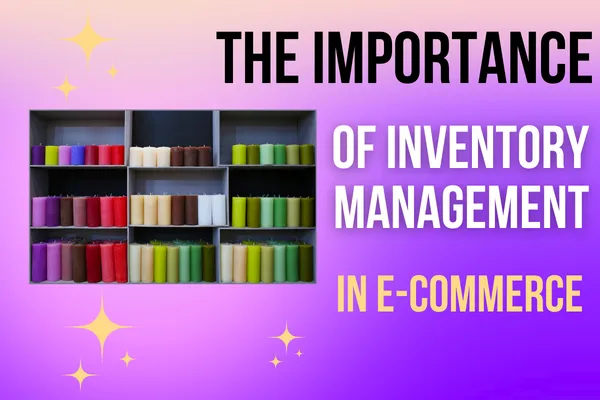E Commerce Blog: Cut Through The Noise & Focus On What Works

The Importance of Effective Inventory Management in Ecommerce
“If you sell a physical product, you have a lot of Q4 upside and unpredictability, but now you have to manage your cash to get to Q4 so that you can invest in building inventory to over-perform.
- Brad Feld
In the bustling world of ecommerce, effective inventory management is the cornerstone of sustainability, especially during the crucial holiday seasons. Consider NatZen, a brand whose lifeblood is the Christmas season—a time of heightened demand and bustling sales. For NatZen, and many other brands, this period is the busiest and most critical of the year.
The founder of NatZen spent years refining their stock management to avoid the pitfalls of oversupply, which inevitably leads to continuous discounting and profit margin erosion. If, like NatZen, you are crafting & making your products yourself and looking to streamline your inventory management, this blog is tailored for you. Stay tuned until the end, as I will be sharing an exclusive Inventory Checklist that will help you plan your inventory for the upcoming seasonal periods and beyond.
What Is Product Inventory Management?
Product inventory management is the organized approach to handling the lifecycle of products within a business. It ensures there's always a balance between supply and demand, minimizing excess stock while avoiding shortages. For handmade businesses like NatZen, it involves keeping a careful eye on raw materials and finished products, predicting sales patterns, and making meticulous plans for storage and distribution.
The 4 Main Steps in Inventory Management
Setting Up Your Inventory: Begin by cataloging your products and implementing a system to track your stock, incorporating tools and software that match the scale of your operation.
Demand Forecasting: Analyze sales data, especially from previous holiday seasons, to anticipate spikes in demand and prepare adequate stock levels without overcommitting resources.
Stock Replenishment: Create a purchasing plan that aligns with your sales forecast, considering both the lead times of your suppliers and the production time for your handmade items.
Inventory Analysis: Use regular inventory reviews to understand sales trends, identify bestsellers, and adjust your stocking strategies accordingly.
The 3 Major Types of Inventory Strategies
Just-In-Time (JIT): Ideal for handmade businesses, JIT involves keeping low inventory and ordering materials just in time for production. This reduces holding costs & also
ABC Analysis: Segment your inventory into categories based on their importance and sales performance, focusing on items that contribute most to your revenue.
Dropshipping: Although not typical for handmade goods, dropshipping can be integrated for non-handmade products you might offer, relieving you from holding inventory for those items.
Organizing Product Inventory
An organized inventory streamlines operations and reduces errors. For NatZen, maintaining a well-ordered stockroom with labeled bins and clear pathways enables efficient picking and packing during the rush of the holiday season.
Managing Inventory in Excel
Excel is a powerful tool for inventory management, allowing you to track stock levels, calculate reorder points, and visualize sales trends with charts and pivot tables. For small to medium-sized businesses, it's an accessible and customizable solution.
Creating an Inventory Checklist
The Inventory Checklist is essential for keeping tabs on your stock. For a brand like NatZen, the checklist includes:
A catalogue of all products, with details like color, size, and category
Current stock levels for each item
Storage locations for easy access and retrieval
Reorder points to prevent stockouts during peak sales periods
SKU numbers for inventory tracking and sales analysis
Conclusion
Effective inventory management can be the difference between capitalizing on the holiday season or getting caught in a cycle of discounting and lost revenue. For handmade businesses, it requires a delicate balance between production capabilities and market demands. NatZen's story demonstrates the potential for success when a well-crafted inventory management system is in place. By incorporating the strategies discussed in this blog and utilizing the Inventory Checklist provided at the end, you’ll be well-equipped to handle the seasonal rush and optimize your inventory for success. Remember, the right planning, tools, and strategies can transform the holiday season into a time of prosperity for your ecommerce business.
Resources to help you get started with Inventory Management:
Woocommerce Inventory Management Softfare
Optimize your inventory, predict customer demand, automate stock replenishment, and manage purchase orders with the Inventory Management for WooCommerce extension.
AI Inventory Management Report
Assisty provides precise inventory forecasting and replenishment advice, along with comprehensive sales reporting to enhance your restocking strategy. Customize settings like vendor lead time, inventory thresholds, and sales history range. The tool automatically generates forecasts, helping you prevent revenue loss from stockouts, reduce excess safety stock, and optimize cash flow.
Also, if you're ready to engage in deeper strategies, join our Soul-Led Ecommerce Facebook Group where you’ll get access to FREE bi-weekly website audits, exciting challenges, and trainings to help your product-based business thrive!
👉 Join the Group

15 Days Boost Your Email List Growth Challenge
Join our fun, easy to implement exclusive "15-Days To Grow Your Email List Challenge and unlock the secrets to expanding your customer base! Whether you're juggling kids, work projects, side hustles this challenge is designed to fit into your hectic life, giving you actionable steps to sky-rocket your email list and drive sales.

PRIVACY POLICY | TERMS OF USE | FAQ | SITEMAP
© Copyrights by Soul Led Ecommerce. All Rights Reserved.
Website optimised by pomegranate.marketing


